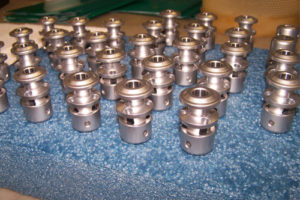A client from the medical industry contacted Imagineering Finishing Technologies for passivation of surgical device components. In order to meet industry required standards for cleanliness, our process engineers developed a cleaning and passivation process that exceeds the medical industry requirements. This passivation process was a chemical cleaning and controlled oxidizing procedure that removed free-iron, metallic, and non-metallic contaminants that remained on the surface of the part after manufacturing. By oxidizing these components, a beneficial layer formed that increased the corrosion resistance of the stainless steel alloys and made the components suitable for use in sterile medical applications, meeting industry requirements. We also met ASTM A380, AMS QQ-P-35, ASTM A967, and AMS 2700 standards.
All passivated components underwent thorough testing that included humidity, salt spray, water immersion, and copper sulfate testing to ensure that the components met the needs of the client and the industry. The table below outlines this chemical passivation of surgical device components project. If you would like additional information, please contact us today.

